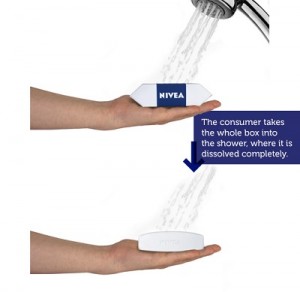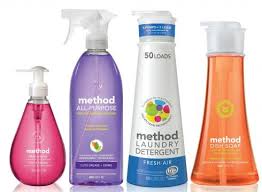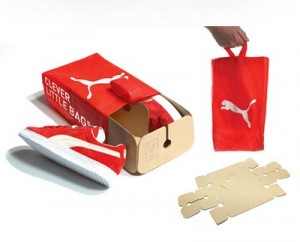We see it everywhere; people and companies alike are committing themselves to going green and doing better for the environment. So, we wanted this blog to focus on those companies that have been working hard to create packaging designs that are just that, environmentally friendly.
We are going take a look at how some well-known companies are taking the necessary steps forward, all the while lessening their carbon footprint towards a healthier, greener society.

Let’s take Nivea, a very popular soap manufacturer, for example, and see how they have ‘cleaned’ up their act. To start, Nivea’s Milk Bar wasted seven grams of paper per package. That may not seem like a lot but, that translates into 3,950 pounds of waste per shipping truck! So, how did Nivea combat this waste? They came up with a dissolving product packaging design. The packaging design works when a consumer takes the entire box into the shower; and, once the water hits the packaging, it dissolves completely. This change in packaging design is working to reduce the waste that was previously being produced.

There is a “method” to the madness; and, the cleaning product brand, Method, is committed to producing products and packaging designs that are environmentally friendly. The brand continually works to integrate sustainability in their packaging designs. There isn’t a particular product that exhibits green qualities, rather, all of their products are green and their bottles are made from 100% recycled plastic. Furthermore, Method places a large focus on the aesthetics of their bottles, because they believe that the product actually “lives” in your home. What do they mean by that? They believe that people are very house-proud and do not want to have ugly cleaning bottles around the house. So, while Method is environmentally friendly, their products are also aesthetically pleasing, which seems to be a win-win for consumers.

When you buy a pair of sneakers, they usually come in a big cardboard box that is, more times than not, thrown away within minutes of getting home. In 2010, Puma came out with a packaging design created by Yves Béhar of Fuseproject. At the forefront of this project was the idea to reduce the size of the common shoebox, which led to the invention of a “clever little bag.” This packaging design is made of a cardboard sheet and the bag uses 65% less cardboard than the common shoebox. Additionally, there is no laminated printing or tissue paper; it takes up less space; it weighs less in shipping and replaces the everyday plastic shopping bag. Puma wasn’t done there; in fact, the “clever little bag” was cleverly made, because it is non-woven, which means that less work and waste were put into the manufacturing process, because it is stitched with heat.
Even the iconic Coca-Cola brand followed suit when, in 2009, they introduced their innovative PlantBottle in the United States. To learn more about their innovative packaging design, read our blog, “The Bottled Up History of Coca-Cola.”
Now more than ever, companies are finding ways to lessen their carbon footprint, all the while protecting the environment for generations to come, through their innovative and creative packaging design ideas and products.
Copyright Davison 2014
Sources:
http://www.buzzfeed.com/mackenziekruvant/disappearing-product-packaging-will-blow-your-mind
http://methodhome.com/methodology/our-story/we-are/
http://www.thedieline.com/blog/2010/11/1/inside-the-studio-method-products.html
http://www.dezeen.com/2010/04/14/clever-little-bag-by-yves-behar-for-puma/
Images:
http://www.beyonddesignchicago.com/wp-content/uploads/2011/07/PUMA-Clever-Little-bag01.jpg
http://www.packagingoftheworld.com/2013/01/the-disappearing-package-nivea-bar-soap.html
http://usatoday30.usatoday.com/news/health/wellness/story/2012-04-11/household-green-cleaning/54324780/1